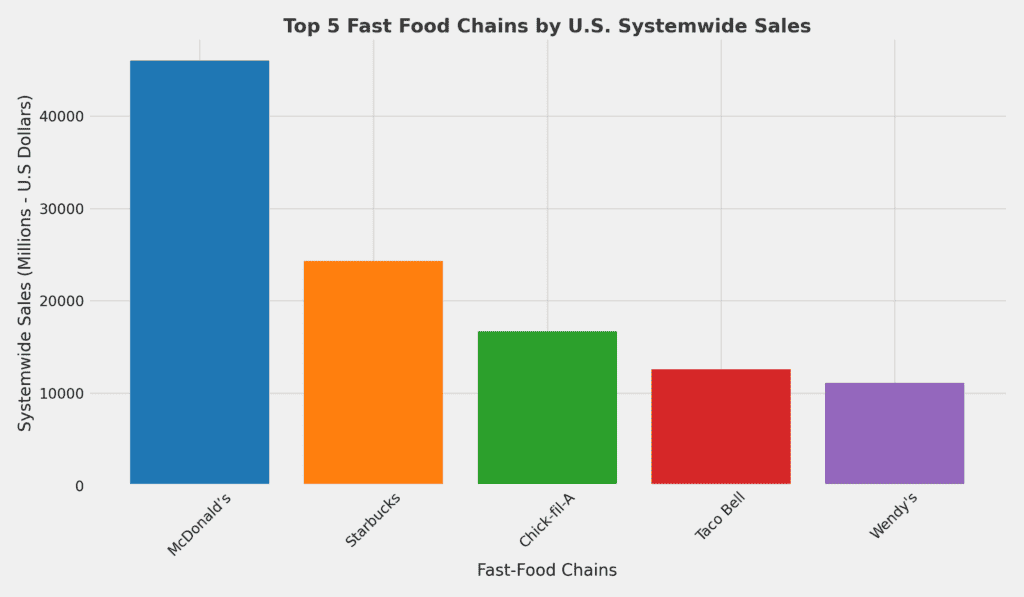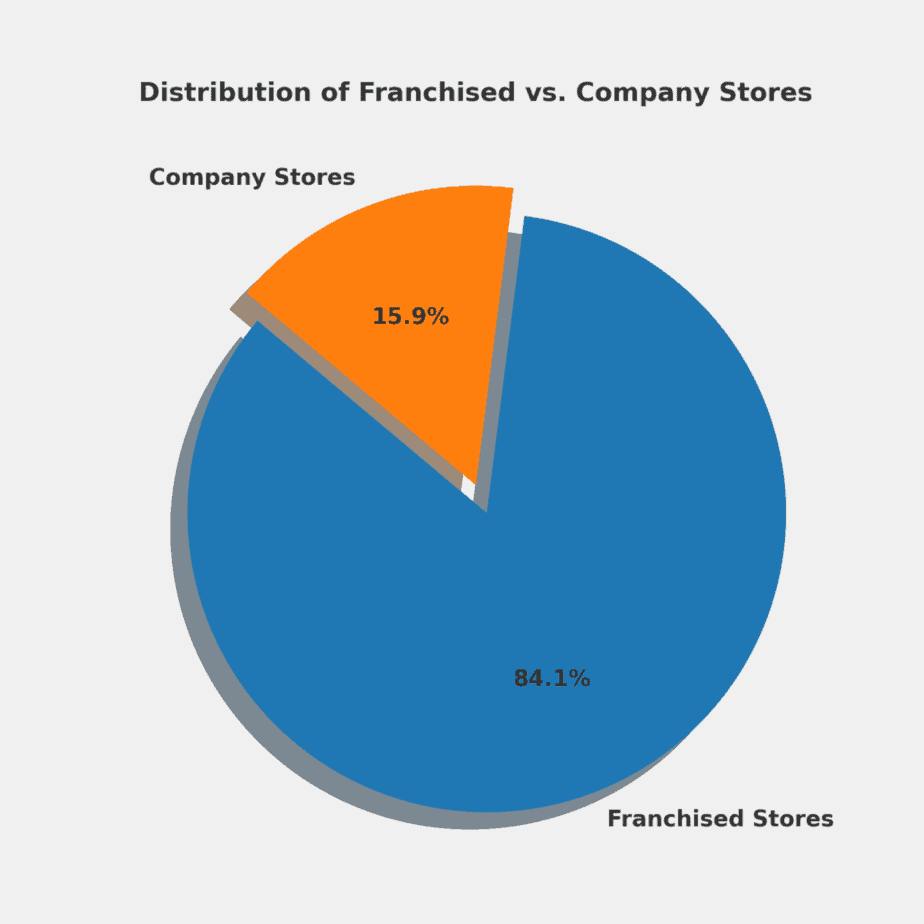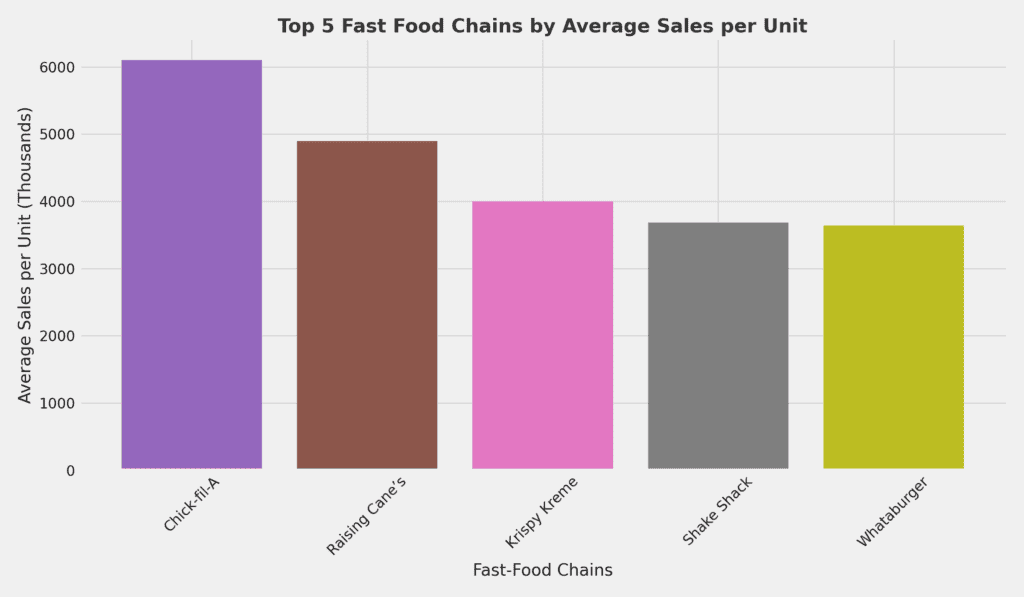In the bustling heart of America’s landscape, fast food chains stand as monuments to convenience, flavor, and the ever-evolving tastes of a nation on the go. From east coast to west coast, these titans of quick service cater to millions, offering everything from mouth-watering burgers to icecreams. As we delve into the “top fast food chains in america” we cover the total sales made by each of these fast food chains, their expansion rate and we rate some of the best top food chains in america.
This article, grounded in meticulous data analysis, serves as your comprehensive guide to understanding which fast food chains reign supreme in the USA. Drawing from an extensive dataset that shines a light on systemwide sales, average sales per unit, and the proliferation of franchised versus company-owned stores, we unravel the secrets behind their success. Whether you’re a curious consumer, or a market analyst, you’ll find value in our exploration of sales data, consumer preferences, and the strategic moves that have propelled these chains to the top of the food chain.
As we cover America’s fast food domain, we’ll uncover the layers that contribute to a brand’s dominance—from menu innovation and marketing genius to adaptation in the face of technological advances and shifting consumer demands. This article doesn’t just rank the top fast food chains in america; it offers a deep dive into the dynamics that define them, the trends shaping their future, and their impact on American dining habits.
Top 10 Fast Food chain in US by their systemwide sales
| Rank | Fast-Food Chain | U.S. Systemwide Sales (Millions – U.S Dollars) |
|---|---|---|
| 1 | McDonald’s | $45,960 |
| 2 | Starbucks | $24,300 |
| 3 | Chick-fil-A | $16,700 |
| 4 | Taco Bell | $12,600 |
| 5 | Wendy’s | $11,111 |
| 6 | Dunkin’ | $10,416 |
| 7 | Burger King | $10,033 |
| 8 | Subway | $9,350 |
| 9 | Domino’s | $8,641 |
| 10 | Chipotle | $7,547 |
This table showcases the top 10 fast food chains in the USA by their systemwide sales, indicating their market position and financial performance within the industry.
Total Sales of various American Fast Food Chains during pandemic
| Fast-Food Chain | U.S. Systemwide Sales (Millions – U.S. Dollars) | Average Sales per Unit (Thousands – U.S. Dollars) | 2021 Total Units | Total Change in Units from 2020 |
|---|---|---|---|---|
| McDonald’s | 45,960 | 3,420 | 13,438 | +244 |
| Starbucks | 24,300 | 1,200 | 15,450 | +113 |
| Chipotle | 7,547 | 2,641 | 2,966 | +198 |
| Taco Bell | 12,600 | 1,823 | 7,002 | +203 |
| KFC | 5,100 | 1,408 | 3,953 | +10 |
McDonald’s: Demonstrating remarkable resilience, McDonald’s continued to expand its global footprint, adding 244 units in 2021. Its significant systemwide sales reflect strong consumer demand and operational efficiency, bolstered by digital innovation and drive-thru services.
Starbucks: Despite challenges to its café-based business model, Starbucks saw substantial growth, opening 113 new locations. The chain’s adaptation through digital ordering and pickup options has played a key role in sustaining its market position.
Chipotle: With a sharp focus on digital sales channels and menu innovation, Chipotle added 198 new units, showcasing its aggressive expansion strategy and the growing consumer preference for healthier dining options.
Taco Bell: Continuing to innovate with menu offerings and leveraging a strong drive-thru presence, Taco Bell expanded by 203 units, underscoring its popularity and adaptability in the fast food landscape.
KFC: Maintained steady growth with a modest increase of 10 units, KFC’s performance reflects sustained consumer loyalty and the effectiveness of its global brand strategy, despite the pandemic’s challenges.
Top Fast Food Chains by U.S. Systemwide Sales
| Rank | Fast-Food Chain | U.S. Systemwide Sales (Millions – U.S Dollars) | Total Units | Change in Units from 2020 |
|---|---|---|---|---|
| 1 | McDonald’s | 45,960 | 13,438 | +244 |
| 2 | Starbucks | 24,300 | 15,450 | +113 |
| 3 | Chick-fil-A | 16,700 | 2,732 | +155 |
| 4 | Taco Bell | 12,600 | 7,002 | +203 |
| 5 | Wendy’s | 11,111 | 5,938 | +57 |
This table highlights the leading fast food chains in the USA based on systemwide sales, showcasing their market dominance and expansion efforts.
Below is the graphical representation of top 5 fast food chains by US Systemwide Sales

Overview of Franchised vs. Company Stores in the Fast Food Industry
| Type | Total Count |
|---|---|
| Franchised Stores | 133,198 |
| Company Stores | 25,175 |
This table provides an aggregated view of the total franchised and company-owned stores across the fast food industry, highlighting the prevalent franchise model.
Below is the pie chart representation of distribution of franchised vs company stores in america

Fast Food Chains with Significant Growth in Total Units (2020 to 2021)
| Rank | Fast-Food Chain | 2021 Total Units | Total Change in Units from 2020 |
|---|---|---|---|
| 1 | Jersey Mike’s | 2,100 | +246 |
| 2 | McDonald’s | 13,438 | +244 |
| 3 | Domino’s | 6,560 | +205 |
| 4 | Taco Bell | 7,002 | +203 |
| 5 | Chipotle | 2,966 | +198 |
This table identifies the chains that exhibited the most significant growth in terms of total units, indicating expansion and increased market presence from 2020 to 2021.
These analyses and tables provide a comprehensive overview of key aspects of the “Top Fast Food Chains in america,” including their sales performance, operational models, and growth trends.
Top Fast Food Chains by Average Sales per Unit
| Rank | Fast-Food Chain | Average Sales per Unit (Thousands – U.S Dollars) | Total Units |
|---|---|---|---|
| 1 | Chick-fil-A | 6,100 | 2,732 |
| 2 | Raising Cane’s | 4,893 | 567 |
| 3 | Krispy Kreme | 4,000 | 358 |
| 4 | Shake Shack | 3,679 | 243 |
| 5 | Whataburger | 3,640 | 873 |
This table showcases chains with the highest average sales per unit, indicating operational efficiency and strong customer demand for their offerings.
Below is the graphical representation of top 5 fast food chains by average sales per unit

The Evolution of Top Fast Food Chains in America
The story of fast food in America is a tale as rich and diverse as the country itself. From its humble beginnings to becoming a cornerstone of modern American culture, the fast food industry has undergone significant transformations. This journey not only mirrors changes in consumer behavior and technological advancements but also reflects the American spirit of innovation and convenience.
The Birth of Fast Food
The inception of fast food can be traced back to the early 20th century, marking a revolution in how Americans consumed meals. The introduction of assembly line techniques into food service drastically reduced waiting times and democratized dining out, making it accessible to the working class. This period saw the birth of iconic chains that would become household names, setting the stage for the fast food phenomenon to sweep the nation.
Fast food’s initial appeal lay in its speed and affordability, catering to the bustling lifestyles of America’s growing urban population. The convenience of grabbing a quick, satisfying meal without the need for traditional sit-down service was revolutionary. As the country’s infrastructure expanded, so did the reach of fast food, with chains strategically positioning outlets along burgeoning highway systems to cater to travelers and commuters.
Pioneers of Convenience
Key players in the early fast food industry set the standards for what would become the fast food model. Brands like McDonald’s and KFC, with their focus on operational efficiency, consistency across outlets, and an emphasis on key items, paved the way for the sector’s expansion. These chains not only standardized the fast food experience but also introduced the franchise model, enabling rapid national and eventually global proliferation.
The franchise model was a game-changer, allowing for uniform quality and service standards while facilitating widespread brand recognition. This approach enabled fast food chains to dominate the American culinary landscape, transforming them from dining alternatives into cultural staples. The success of these early pioneers was built on a foundation of innovation, from the introduction of the drive-through to the development of iconic menu items that appealed to a broad audience.
Milestones in Fast Food Evolution in America
| Year | Event |
|---|---|
| 1921 | White Castle, often considered the first fast food chain, opens its doors. |
| 1940 | McDonald’s is founded, introducing the Speedee Service System. |
| 1952 | KFC begins franchising, popularizing chicken in the fast food industry. |
| 1960s | The drive-through concept gains popularity, revolutionizing fast food service. |
This table highlights key milestones that underscore the rapid evolution and enduring impact of fast food in America. Each event marks a significant leap forward in how fast food chains operated and expanded, contributing to the industry’s colossal growth.
The evolution of fast food in America is a testament to the industry’s ability to adapt and innovate in response to changing consumer demands and societal shifts. From its early days of serving simple, speedy meals to becoming a global phenomenon, fast food has indelibly shaped the American dining experience, reflecting the nation’s values of convenience, efficiency, and ingenuity.
Analyzing the Giants: Who Leads the Pack?
In the fast-paced world of fast food, certain brands have risen to prominence, defining the very essence of quick service dining across the United States. These giants of the industry not only cater to millions of hungry customers daily but also set trends that shape the future of fast food. With an in-depth analysis of the latest data, let’s uncover which chains lead the pack in sales and expansion, highlighting their strategies for success and growth.
Dominance in Sales
When it comes to sales, three chains stand out for their remarkable performance, showcasing the vast appetite for fast food in America. Burger King, with its iconic Whopper, has demonstrated significant prowess in the industry with U.S. systemwide sales reaching a staggering $10,033 million. This reflects not just brand popularity but also the effectiveness of its marketing strategies and menu innovation.
Arby’s, famous for its roast beef sandwiches and unique offerings, follows with sales amounting to $4,462 million, proving that niche focus combined with quality can lead to substantial success. These figures not only signify financial strength but also the trust and loyalty they’ve garnered from consumers nationwide, underlining their dominance in the fast food market.
Top Fast Food Chains by Sales in America
| Rank | Fast-Food Chain | U.S. Systemwide Sales (Millions – U.S Dollars) |
|---|---|---|
| 1 | Burger King | 10,033 |
| 2 | Arby’s | 4,462 |
(Note: The table lists the top chains by sales based on the available data. For a complete analysis, please refer to the full dataset.)
Expansion and Growth
The landscape of fast food is constantly evolving, with chains tirelessly working to expand their reach. Burger King, for instance, has shown notable growth with a total of 7,105 units in 2021, a testament to its aggressive expansion strategy and its ability to resonate with consumers across different markets. This expansion is not just about quantity but also about enhancing brand presence and accessibility, making it a key player in the fast food arena.
Arby’s, on the other hand, maintains a strong network of 3,409 units, balancing between franchised and company stores to optimize operations and maintain quality. The growth of these chains reflects a strategic approach to expansion, focusing on market penetration and sustaining relevance in the competitive fast food landscape.
Fast Food Chains by 2021 Total Units
| Rank | Fast-Food Chain | 2021 Total Units |
|---|---|---|
| 1 | Burger King | 7,105 |
| 2 | Arby’s | 3,409 |
(Note: The table showcases the chains’ growth in terms of total units based on the provided data. For comprehensive insights, the full dataset should be considered.)
Through rigorous analysis, it’s clear that the giants of the fast food industry have carved out their success through a combination of strategic sales initiatives and thoughtful expansion.
The Recipe for Success: What Makes a Top Fast Food Chain
In the sizzling arena of the fast food industry, certain brands have mastered the recipe for success, setting themselves apart from the competition. This section delves into the key ingredients that contribute to the making of a top fast food chain. Utilizing the latest dataset, we explore the factors that have propelled brands like Arby’s and Burger King to the forefront of the industry.
Consistent Quality and Innovative Menus
The cornerstone of any successful fast food chain is the consistent quality of its offerings. Arby’s, known for its roast beef sandwiches and unique meats, has maintained a loyal customer base by ensuring that every visit meets their high standards. This commitment to quality is matched by their menu innovation, regularly introducing new items to keep the dining experience exciting and appealing.
Burger King has similarly placed a high emphasis on both quality and innovation. Their introduction of the Impossible Whopper, a plant-based alternative, is a prime example of how they’ve adapted to changing consumer preferences. This balance of traditional favorites with new, trend-setting options keeps customers coming back, demonstrating the power of innovation in the fast food sector.
Strategic Expansion and Customer Experience
Another critical aspect of a top fast food chain’s success is its strategic expansion and focus on customer experience. Burger King, with over 7,000 units, has effectively penetrated the market by placing its outlets in high-traffic locations and continuously optimizing its service model to enhance convenience for its patrons.
Arby’s has shown impressive growth, with a significant increase in units, reflecting its strategic approach to expansion. By carefully selecting locations and focusing on markets with high demand, Arby’s ensures that its brand is accessible and top of mind for consumers. This, combined with a customer-centric approach that emphasizes speed, convenience, and friendly service, solidifies its position as a leading chain.
Key Success Factors of Top Fast Food Chains
| Factor | Arby’s | Burger King |
|---|---|---|
| Quality | High Standards | Consistent |
| Menu Innovation | Unique Meats | Impossible Whopper |
| Strategic Expansion | Growing Units | Over 7,000 Units |
| Customer Experience | Speed & Service | Convenience |
This exploration into what makes a top fast food chain reveals that success in this competitive industry is multifaceted. Brands like Arby’s and Burger King thrive by not only maintaining the quality and innovation of their menu offerings but also by strategically expanding their reach and prioritizing the customer experience.
Also its important to know the revenue of top fast food chains in the USA.
Trends Shaping the Future of Fast Food in the USA
The fast food industry in the United States is at a pivotal crossroads, with emerging trends reshaping the landscape of quick-service dining. As we delve into the future of fast food, it’s crucial to understand the forces driving change and how top chains are adapting to stay ahead. Utilizing the latest data, this section explores the significant trends that are expected to dominate the industry.
Embracing Technology and Digital Ordering
The digital revolution has made its mark on the fast food sector, with technology becoming a cornerstone of the dining experience. Chains like Burger King and McDonald’s are leading the charge, integrating mobile ordering, contactless payments, and AI-driven recommendations into their operations. This shift towards digital platforms not only enhances customer convenience but also streamlines operations, reducing wait times and improving order accuracy.
The adoption of technology extends beyond ordering, with many chains exploring delivery partnerships and digital loyalty programs to engage customers. These initiatives reflect a broader trend towards personalization and convenience, catering to the needs of a digitally savvy consumer base. As technology continues to evolve, its role in the fast food industry is set to grow, transforming how consumers interact with their favorite brands.
Focus on Health and Sustainability
Consumer preferences are shifting towards healthier dining options and environmentally friendly practices, prompting fast food chains to reconsider their menus and operations. The rise of plant-based alternatives, as seen with Burger King’s Impossible Whopper, signifies a move towards more sustainable and health-conscious offerings. This trend is not just a fad but a reflection of growing consumer awareness and demand for ethical, nutritious food choices.
Sustainability extends to packaging and waste reduction, with chains adopting recyclable materials and minimizing single-use plastics. These efforts align with a broader societal push towards environmental stewardship and underscore the fast food industry’s role in addressing global sustainability challenges. As consumers become more eco-conscious, chains that prioritize health and sustainability are likely to gain a competitive edge.
Key Future Trends in Fast Food
| Trend | Description |
|---|---|
| Digital Transformation | Integration of mobile ordering, contactless payments, and AI-driven services. |
| Health and Sustainability | Introduction of plant-based options, focus on nutrition, and adoption of eco-friendly practices. |
These trends highlight a dynamic period of evolution for the fast food industry, driven by technological innovation and changing consumer values. As top chains adapt to these shifts, the landscape of quick-service dining is set to transform, offering new opportunities for growth and engagement. The future of fast food in the USA promises to be both exciting and challenging, with technology and sustainability at the forefront of change.
Financial and Expansion Indicators for Fast Food Chains in the USA
| Indicator | Value | Implication |
|---|---|---|
| Average Sales per Unit (Thousands – U.S Dollars) | $1,857.66 | Indicates chains’ financial capacity for investment in technology and sustainability. |
| Total Change in Units from 2020 to 2021 | +1,485 units | Reflects industry growth and potential for adopting new technologies and sustainable practices. |
Regional Fast Food Gems in America
The vast landscape of the fast food industry in the USA is dotted with both towering giants and smaller, yet equally cherished, regional favorites. This section dives into the fascinating world of chains that, while they may not boast the sprawling presence of industry behemoths, command loyal followings and offer unique menu items that reflect local tastes and traditions.
Celebrating Regional Diversity
The United States is a melting pot of cultures and culinary preferences, a fact that is mirrored in its fast food offerings. Chains like Bojangles, with its Southern roots, have carved out a niche with their distinctive take on comfort food, serving up fried chicken, biscuits, and sweet tea that resonate deeply with regional tastes. This focus on regional specialties not only endears them to local communities but also attracts curious foodies from beyond their traditional locales.
Bojangles’ success, underscored by its significant presence in the Southeast, highlights the potential for chains that adeptly cater to regional preferences. By embedding themselves in the cultural and culinary fabric of their regions, these chains achieve a sense of authenticity and community connection that larger chains often strive to replicate.
Uncovering Hidden Gems
Beyond the well-trodden paths of national fast food giants lie hidden gems that offer unique dining experiences. Baskin-Robbins, while known for its extensive ice cream selection, also surprises with regional flavor offerings that cater to local palates. This strategy of localizing menus allows chains to cultivate a sense of discovery among patrons, turning every visit into an opportunity to explore new tastes.
The presence of Baskin-Robbins across the nation, with a notable number of units, serves as a testament to the appeal of offering a diverse range of flavors and experiences. This approach not only broadens their customer base but also enhances brand loyalty by continuously engaging consumers’ curiosity and taste for adventure.
Visit our site for more information on food recipes and food related content.
Regional Chains and Their Unique Offerings
| Chain | Region | Specialty Item | 2021 Total Units |
|---|---|---|---|
| Bojangles | Southeast | Fried Chicken & Biscuits | 773 |
| Baskin-Robbins | Nationwide | Ice Cream Varieties | 2317 |
This exploration of regional favorites and hidden gems in the fast food industry reveals a vibrant tapestry of flavors and experiences that cater to a wide array of tastes and preferences.
Diverse Fast-Food Chain Responses to the Pandemic
| Fast-Food Chain | Adaptation Strategy | Impact on Operations |
|---|---|---|
| McDonald’s | Enhanced digital ordering and pickup | Maintained customer engagement |
| Starbucks | Boosted mobile app and drive-thru | Mitigated impact of reduced foot traffic |
| Chipotle | Expanded digital sales and “Chipotlanes” | Significant growth in digital orders |
| Domino’s Pizza | Focused on delivery and efficiency | Saw sales growth with increased delivery demand |
| Taco Bell/KFC | Leveraged drive-thru and digital ordering | Adapted to operational challenges effectively |
In this comprehensive exploration of the “Top Fast Food Chains in america” we’ve delved into the heart of what makes these brands not just survive but thrive in a fiercely competitive landscape. From McDonald’s commanding lead in systemwide sales to Starbucks’ global coffee dominance, and Chick-fil-A’s remarkable efficiency in average sales per unit, each chain has carved out its niche through a blend of strategic innovation, operational excellence, and keen market insight. The resilience of Taco Bell, the steady growth of Wendy’s, and the pioneering digital strides of Domino’s highlight the industry’s adaptability and relentless pursuit of customer satisfaction.
The dynamic interplay between franchised and company stores reveals a complex business models, with Subway’s extensive network underscoring the power of franchising, while Chipotle’s corporate-led strategy underscores a commitment to quality and control. This analysis not only illuminates the financial metrics that underscore success but also paints a vivid picture of the evolving fast food landscape, shaped by consumer preferences, technological advancements, and the relentless drive for growth.
As we close this chapter, we invite you—the reader, the entrepreneur, the enthusiast, or the casual diner—to reflect on the transformative journey of these culinary giants. Let their stories inspire you to explore new tastes, consider the impact of your dining choices, or even envision your venture within this bustling sector. Remember, the essence of the fast food industry lies not just in the meals served but in the experiences created, the communities built, and the innovations fostered.


